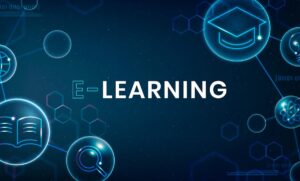
In today’s swiftly evolving terrain, innovation isn’t just a trendy term; it’s an absolute imperative, and the realm of education is not immune to its sway. As the digital age persists in reshaping our lifestyles and professions, maintaining a competitive edge in the realm of online education necessitates a departure from conventional teaching approaches. In this article, we will plunge into the dynamic sphere of online education, examining the ever-shifting landscape, dissecting ten propitious innovations, and dispensing priceless guidance on formulating a triumphant e-learning marketing strategy.
The Evolution of Online Education

The journey of online education is a testament to the ever-advancing realm of technology. What started as a novel concept has now become a cornerstone of modern learning. Online education has witnessed a remarkable evolution, shifting from simple text-based courses to highly interactive and immersive experiences.
Today, online learners can engage with a diverse range of multimedia content, from videos and simulations to virtual reality experiences. The integration of technology has democratized education, breaking down geographical barriers and providing access to knowledge on a global scale.
The Challenges of Innovation
Though innovation in education promises great potential, it comes with its set of hurdles. Educators and institutions might encounter pushback against change, financial limitations, and the demand for extensive training in emerging technologies. Nevertheless, by recognizing and actively addressing these obstacles, the education sector can unlock the complete potential of innovation.
Crafting a Successful E-Learning Marketing Strategy

In the ever-expanding world of online education, marketing plays a crucial role. With countless courses and platforms available, standing out and attracting learners is a unique challenge. A successful e-learning marketing strategy involves:
- Understanding Your Audience: Identify your target audience, their needs, and preferences. This step is crucial in tailoring your offerings to meet their demands effectively.
- Leveraging Technology: Use cutting-edge marketing technologies, such as data analytics and AI, to reach the right audience with the right content at the right time.
- Feedback and Improvement: Continually collect feedback from learners to improve your courses and services.
- Content Creation: Develop high-quality content that showcases your expertise and the value of your educational offerings.
- Engagement: Engage with your audience through various channels, including social media, email marketing, webinars, and forums.
- Collaboration: Collaborate with influencers and industry experts to gain credibility and expand your reach.
Crafting an effective e-learning marketing strategy is a dynamic and multi-faceted undertaking. In the constantly shifting terrain of online education, innovation stands as the linchpin for triumph. By seamlessly integrating the latest trends and technologies into your marketing approach, you can surge ahead of your competitors and forge a captivating and productive learning experience for your specific target audience.
Critical components of a victorious e-learning marketing strategy encompass pinpointing your distinctive audience, conducting comprehensive market research, and customizing your curriculum to precisely align with the unique requirements and preferences of your learners. Additionally, embracing groundbreaking innovations in online learning, such as adaptive AI systems, virtual and augmented reality, and gamification, can set your educational enterprise apart and attract a broader spectrum of learners.
Keep in mind that the key to sustained success lies in the continuous adaptation and refinement of your strategy in response to the ever-evolving online education landscape. Through this commitment, you can position your e-learning platform for enduring growth and equip learners to thrive in our increasingly digital world.
Innovations in Online Learning

The winds of change are blowing through the realm of online learning, propelling education into a bold new future and fundamentally altering how we acquire knowledge and hone our skills. With the guidance of artificial intelligence, personalized learning journeys are becoming the norm, tailored to each individual’s unique needs. Meanwhile, the mesmerizing landscapes of virtual and augmented reality are rendering traditional educational approaches obsolete, immersing learners in captivating and interactive experiences that defy convention.
These remarkable innovations are reshaping the very essence of education as we know it.
- Adaptive Learning Systems: These innovative systems use AI algorithms to tailor learning experiences to individual students. By analyzing a student’s progress, strengths, and weaknesses, adaptive systems adjust the content and pace to optimize learning.
- Artificial Intelligence (AI) in Education: AI-driven tools can analyze student performance data to provide personalized recommendations. These tools help educators identify areas where students may struggle, offering timely interventions.
- Gamification: Learning through play adds an element of fun and engagement to education. Gamification elements like points, badges, and leaderboards motivate students to actively participate and compete.
- Microlearning: In a fast-paced world, bite-sized lessons are gaining prominence. Microlearning delivers short, focused content, accommodating shorter attention spans and providing information for immediate application.
- Mobile Learning: The ubiquity of smartphones and tablets has given rise to mobile learning. Educational apps and mobile-friendly content enable learning on the go.
- Video-Based Learning: Video content enhances engagement. Many learners find video lessons more captivating and accessible than traditional text-based materials.
- Virtual Reality (VR) and Augmented Reality (AR): The introduction of VR and AR technologies has revolutionized the learning experience. Students can now immerse themselves in virtual environments, making complex subjects more accessible and engaging.
- Blockchain in Education: Blockchain technology is being used to verify and securely store educational credentials, providing a transparent and tamper-proof system for certifications.
- Learning Analytics: Educational institutions are increasingly using data analytics to assess and improve their programs continually. Analyzing student performance data helps refine curricula and teaching methods.
- Social Learning Platforms: Digital platforms allow students from around the world to collaborate on projects, expanding their cultural understanding and problem-solving skills. Such collaborations prepare students for a globalized workforce.
One groundbreaking innovation is adaptive learning systems, which harness the power of AI to customize learning experiences for individual students. This ensures that learners receive precisely what they need to succeed, at their pace.
Virtual reality (VR) and augmented reality (AR) are taking learning to new heights. Through these technologies, students can explore historical events, dive into complex scientific concepts, and undertake hands-on training in a virtual environment.
Furthermore, the gamification of learning introduces elements of competition and rewards, motivating learners to actively participate and excel in their studies.
These innovations are not just enhancing education; they’re making it more accessible, engaging, and effective for learners of all ages and backgrounds.
Conclusion
Innovation and development in education are vital for staying competitive in the ever-evolving world of online learning. As technology continues to reshape the educational landscape, those who adapt and innovate will lead the way in shaping the future of learning. Remember, the success of your e-learning marketing strategy hinges on staying innovative and relevant in this ever-changing landscape. By implementing these strategies and embracing technology, you can create engaging and effective online education experiences for your students.




